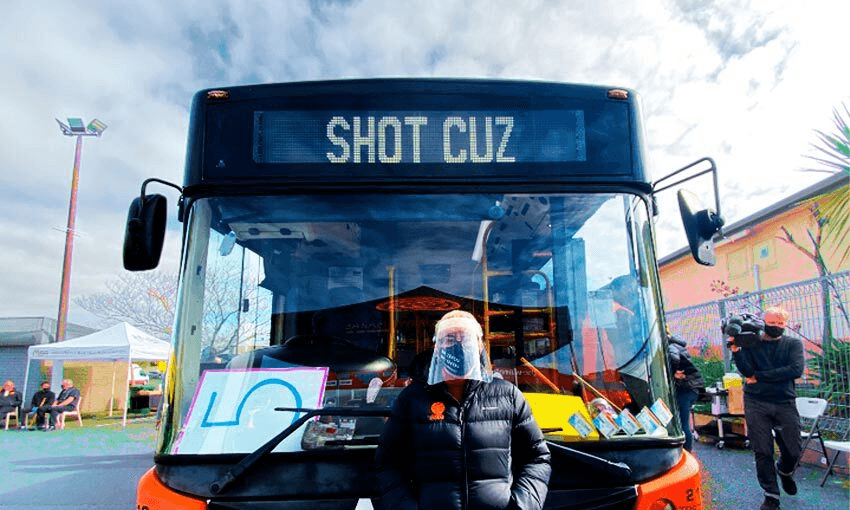With the pressure on to increase Auckland’s vaccination rates, Justin Latif checked out a new bus service taking the jab to the people.
As a karakia was being uttered to mark the unveiling of the Shot Cuz vaccination bus, Takutai Moana Natasha Kemp says tears began welling up in her eyes.
“This is what our community has been asking for. It’s about keeping our whānau safe and protecting our whakapapa,” says Kemp, the Manurewa Marae chief executive.
The bus is one of 12 being deployed throughout Auckland by the Northern Regional Health Coordination Centre (NRHCC), with this one set to park up at a number of popular sites around Manurewa over the coming weeks. The converted buses are from Auckland Airport’s Park and Ride fleet, can do up to 300 shots per day and will be staffed by 12 staff, including vaccinators, observers, cold chain managers and administration staff.
With a clear spring sun shining on, Monty Cassidy and Hunter-Breeze Maihi were the first among a sizeable group outside the Clendon Pak’n’Save waiting to get their shots on Tuesday. The pair were both receiving their first dose and despite some nerves, said they felt good about getting vaccinated. With so many locations in the Clendon area named as locations of interest, Cassidy said he felt being vaccinated would make it easier “to be out in the community again”.
Maihi admitted she had been “nervous and hesitant” when the vaccine was first mooted, but after hearing from Māori immunologists that it’s safe she felt reassured.
“I have two young children who I really don’t want to catch the virus, so I’m getting vaccinated so we can stop its spread in the community.”
Kemp, whose marae has already vaccinated over 30,000 people since April, says they have been pushing for a means to take vaccinations out into the community.
“This isn’t about reaching a certain number, this is about reaching our Māori and Pacific community, it’s about building trusting relationships and it’s about manaakitanga.”
After some discussion, the marae decided to rename their bus, she says. Rather than Shot Bro, the name given to it by the Ministry of Health, it is now Shot Cuz.
“There was widespread approval from the community, as it’s more gender neutral and it’s how our whānau talk, like, ‘hey cuz, come on down, if you need a shot’,” she says.
And while she’s had very little negative feedback about the vaccination, she is encouraging people to speak to one of the many clinical staff onsite should they still be concerned. “If you’re worried, come and have a conversation with us, as a lot of us have seen a lot of whānau get vaccinated now.”
Manurewa resident and Green Party co-leader Marama Davidson was among dignitaries at the Shot Cuz unveiling. She says she was particularly pleased to see local providers being used to help with the vaccine rollout. “It’s the relationship and the trust that is going to make the difference to get these looser vaccinated neighbourhoods protected, so I’m really pleased to see the buses coming to south Auckland, particularly places like Clendon.”
NRHCC lead and Counties Manukau Health chief executive Margie Apa was also onsite for the bus blessing. She says the buses are part of a wider effort to make the vaccine more accessible, including for those with disabilities or mobility issues.
“Rather than them coming out, we’re trying to make accessible options, so we will have mobile teams who are able to go into people’s homes as well.”
She says increasing vaccination rates is particularly crucial in south Auckland because, despite Middlemore hospital being well-prepared for Covid, more cases would inevitably lead to fewer resources for non-Covid patients.
“We have done quite a lot of preparatory work to both our ICU and high dependency units, so we can take up to 60 at any one time,” she says. “But it’s hard to avoid Middlemore being the epicentre [of the outbreak] as it’s the closest ED [emergency department] for people to walk into.”
She says the hospital’s patient load is “manageable“ at level four and three because fewer people are getting unwell but once the city moves out of level three, the pressure for more services will increase.
“If we can get our whole community vaccinated, that opens up our options in terms of how we go back to providing more services to the community.”
And Apa says collaborative initiatives like this are cause for optimism that that goal is achievable.
“As you see today we’ve got Māori providers, DHB staff and the local businesses all supporting each other for this. And the region’s hospitals have also come together much more over this year than in the past.
”It’s really taken a whole system effort, which I call a team of teams, and I think that’s what will get us through.”
